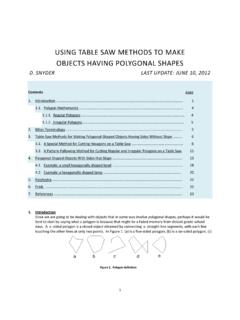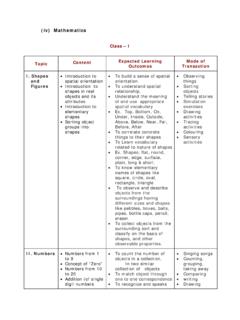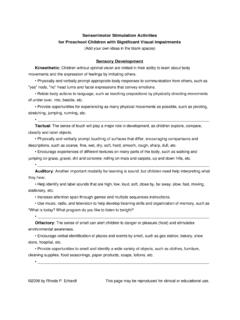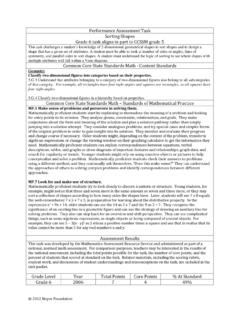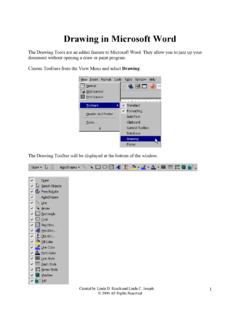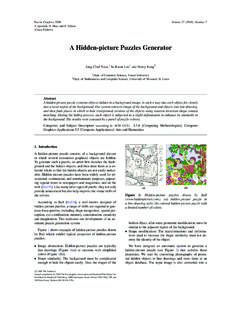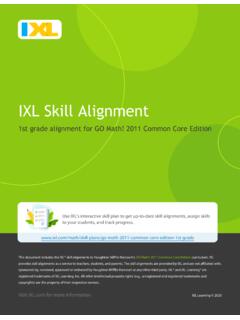Transcription of Properties)of)Objects) - VDOE
1 Science Enhanced Scope and Sequence Kindergarten Virginia Department of Education 2012 1 properties of Objects Strand Matter Topic Describing properties of objects Primary SOL The student will investigate and understand that the position, motion, and physical properties of an object can be described. Key concepts include c) textures and feel of objects; d) relative sizes and weights of objects; e) relative positions and speeds of objects. Related SOL The student will demonstrate an understanding of scientific reasoning, logic, and the nature of science by planning and conducting investigations in which a) basic characteristics or properties of objects are identified by direct observation; c) a set of objects is sequenced according to size; d) a set of objects is separated into two groups based on a single physical characteristic; h) observations are recorded; i) picture graphs are constructed; k) objects are described both pictorially and verbally.
2 The student will investigate and understand that the position, motion, and physical properties of an object can be described. Key concepts include a) colors of objects; b) shapes and forms of objects. Background Information Objects have properties that can be observed and described. Physical properties include size, shape, and texture. An object can be described according to its motion and its position relative to another object . Two different objects can have common physical properties . In this lesson, students will sort and graph. They will create a human bar graph and a picture graph. Materials Assorted balls ( , baseball, golf ball, tennis ball, lacrosse ball, wiffle ball, marble, foam football, stress ball, texture ball, basketball, soccer ball, pillow ball, exercise ball, bouncy ball, kickball) Graphing mat, shower curtain with a grid pattern, or square tile flooring Bulletin board paper Drawing paper cut a large circle for each student Chart paper Large plastic tub or baby pool to hold balls (optional) Science Enhanced Scope and Sequence Kindergarten Virginia Department of Education 2012 2 Vocabulary color words (include colors of the balls)
3 , shape words, flexible, stiff, straight, curved, rough, smooth, hard, soft, heavy, light, long, short, wide, thin, big, little, large, small, over, under, in, out, above, below, left, right, speed, fast, slow Student/Teacher Actions (what students and teachers should be doing to facilitate learning) Introduction 1. Gather students around the balls, and ask them to name and describe them using shape, texture, size, and weight. Compare the balls, and predict which one has a larger diameter. Measure them using a nonstandard unit, such as a given length of string. Sequence the balls by size. Select a few balls, and make predictions as to which will bounce the highest; test to find out. 2. Have students sort the balls in a variety of ways (big/little, red/not red, smooth/bumpy, etc).
4 See how many ways the balls can be classified. Procedure 1. As a class, choose four or five balls that represent games students like to play. Place these balls in various locations in the classroom. Have students stand near the balls that represent their favorite game. Ask students what they can tell about the class by the balls they are standing near. Ask if there is a better way to show who likes each sport. Guide students to the idea of standing in a line behind their favorite ball. To create a human bar graph, students can line up by standing on floor tiles, a graphing mat, a shower curtain with a grid pattern, or paper squares that are firmly attached to the floor. Discuss how it is easier to see how many students are in each group.
5 Compare the groups, and ask which game has the most students, which one has the fewest, etc. Record the results on chart paper. 2. To make a picture graph, give each student a precut ball to color to represent the game he/she liked the best. Have students return to the human graph area and place their balls on the square in which they were standing. Observations and Conclusions 1. Discuss the graph. 2. Have students compare with the results recorded on the chart paper. Ask, Do both graphs show the same information? Assessment Questions o Observe students as they discuss the properties found in balls. Are they able to name and distinguish several different properties ? Can students sort according to a given property?
6 Journal/Writing Prompts o Have students graph a collection of small objects at their desks. Science Enhanced Scope and Sequence Kindergarten Virginia Department of Education 2012 3 Other o Set up a ramp. Select several different kinds of balls. Before you roll any balls down the ramp, have students predict which one they think will roll the fastest, which the next, etc. Have them give an explanation for their choices. Roll the balls down a ramp. Discuss how accurate students predictions were and the reasons they were or were not accurate. Extensions and Connections (for all students) Have each student bring in a mystery object from home in an opaque bag. Have each student give clues based on the physical properties of his or her mystery object .
7 Have the class guess what the object is based on these clues. Students can also write or dictate a sentence describing their mystery object . Encourage the use of the vocabulary covered in the lesson. Verbally give students descriptive clues, and ask them to draw what you are describing. For example: The object is big, heavy, and gray. It is alive. It can be found at the zoo. Its skin would feel rough. Students should draw an elephant. Strategies for Differentiation Use clip art to generate pictures of the balls to be available for use in graphing activities. Videotape the students conducting the real- people graphing activity for repetition to reinforce comprehension of concepts. Use digital pictures of students to make a picture graph.
8 Using sticky notes, create a second class- generated symbolic graph replicating the data represented on the picture graph. Match pictures of athletes in a specific sport to the corresponding ball used for that sport. Lead students on a walk inside the school to search for other graphs displayed by other classes. Have pairs of students create symbolic graphs, using round, colored stickers. Display an example of each type of graph for reference ( , graph made with fruit loops, graph made with colored circles, graph made with sticky notes). Help students create a class book of pictures used when determining size, weight, shape, and textures of objects. Label each picture.












